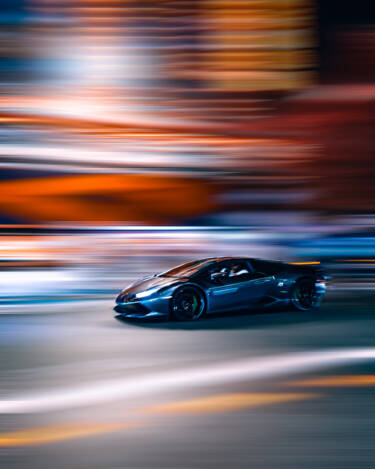Panning photography – an advanced masterclass

Transform ordinary moving objects into compelling visual stories through panning, says street photographer extraordinaire Ben Moore
Panning photography is a dynamic technique that captures the essence of motion by smoothly tracking a moving subject with your camera while using a slower shutter speed. Mastering this technique allows you to create images where the subject remains relatively sharp and the background is blurred, conveying a powerful sense of speed and fast movement. This effect isolates the subject, drawing the viewer’s eye to the key point of interest while simultaneously suggesting movement and energy.
Panning photography requires practice in smoothly following the subject’s path and finding the right balance between shutter speed and panning motion, but the results can be truly captivating.


Getting started:
Track the subject
Move your camera horizontally, following the subject’s movement as it passes in front of you.
Slow shutter speed
Use a relatively slow shutter speed (e.g. 1/15th to 1/30th of a second) to create motion blur in the background.
Sharp subject
By smoothly panning your camera with the subject, you can keep it relatively sharp while the background streaks with motion blur.
Camera gear
Any camera that allows you to control shutter speed and ideally offers some form of image stabilisation (either in-body or lens-based) will work. I favour the Nikon Z8. A camera with a fast-burst shooting mode can also be helpful for capturing a series of shots, increasing your chances of getting a perfectly sharp image.
A fast aperture (f/2.8 or lower) allows you to isolate the subject and blur the background depending how you want your composition to sit. This gives more creative options when editing the final image in post.
PolarPro Peter McKinnon Variable ND Signature Edition II
A variable neutral density (VND) filter reduces the amount of light entering the camera lens. This allows photographers to use slower shutter speeds, even in bright daylight, which is essential for techniques such as panning, where selecting a slower shutter speed would overexpose the image. By blocking excess light, a VND filter prevents overexposure while enabling the creation of motion blur. This makes it an invaluable tool for any serious photographer.
Camera settings
Manual mode
Manual mode gives you complete control over all three key exposure settings: shutter speed, aperture and ISO. By setting these manually, you lock in your desired exposure and ensure that it remains constant throughout your shoot.
When using an Auto mode, the camera constantly analyses the available light and adjusts settings accordingly. In a dynamic environment, such as a street at night with moving cars, the light is constantly changing. Headlights, streetlights and reflections create a chaotic mix of illumination. If you’re using Aperture Priority, for example, the camera will continuously adjust the shutter speed to maintain your chosen aperture. This means that as a car with bright headlights enters the frame, the camera will shorten the shutter speed, and, as it leaves, it will lengthen it. This leads to inconsistent exposure and motion blur across your series of panning shots. Panning relies on a consistent shutter speed to achieve the desired motion blur. If your shutter speed is changing with every shot, you’ll get wildly different results, making it impossible to achieve a consistent look.
This also allows you to fine-tune your settings to achieve the exact look you want. While Manual mode provides consistency, it also allows you to make adjustments as needed. If you notice that your images are consistently overexposed or underexposed, you can quickly adjust your settings to compensate. This level of control is simply not possible with Auto modes. Imagine panning a car at night. With Aperture Priority, the camera might choose a 1/30th second shutter speed as the car approaches, then switch to 1/125th second as the headlights brighten the scene, and then back to 1/30th as the car moves away. This results in inconsistent motion blur and exposure, making your images unusable. In Manual mode, you can lock in a shutter speed of, say, 1/60th second, and maintain that throughout the entire sequence, ensuring consistent and predictable results.
Autofocus continuous single point
When honing your panning photography skills, using autofocus continuous single point (AF-C) is crucial. This mode allows the camera to track a moving subject, maintaining focus as it travels across your frame. By selecting a single focus point, you dictate exactly where the camera should prioritise sharpness, ensuring that your subject remains in focus even as the background blurs. This precision is vital for capturing sharp, dynamic panning shots, as it prevents the camera from randomly shifting focus to the background or other elements within the scene. Consistent focus on your subject is the foundation of a successful panning image and AF-C with a single focus point provides the reliability needed for effective practice.
Shutter speed
Typically, slower shutter speeds, ranging from around 1/15th to 1/30th of a second, are used to create the desired effect. However, the ideal shutter speed will depend on the subject’s speed and distance, requiring experimentation to find the sweet spot.
In low-light conditions the challenge lies in balancing the need for a slow shutter speed to achieve motion blur with the risk of excessive camera shake. This is where experimentation becomes crucial. Don’t be afraid to push the boundaries and try even slower speeds. The interplay of motion blur and limited light can create a captivating atmosphere, transforming ordinary scenes into something extraordinary.


Composition tips
Composition is key to taking your panning shots from good to great. Here’s a breakdown of tips to consider.
- While not always strictly necessary, the rule of thirds can still be a helpful guideline. Try placing your subject at one of the intersections of the imaginary lines that divide your frame into thirds.
- Pay attention to the background. A clean and uncluttered background will make your subject stand out more. However, a background with interesting patterns or textures can also add to the dynamism of the shot (as in the photographs above).
- Consider where your subject is in relation to the frame. Leaving some space in front of the subject, in the direction it’s moving, can enhance the feeling of motion. It’s like giving the subject ‘room to run’.
- Including foreground elements, such as a blurred tree branch or a fence post, can add depth and context to your panning shots.
- Conversely, using negative space (empty space around your subject) can also be effective, especially if you want to emphasise the subject’s isolation or speed.
- Panning is typically done horizontally (so left to right), but don’t be afraid to experiment with slight vertical panning if the situation calls for it.
- Follow through: remember to continue following the subject’s movement with your camera even after you’ve taken the shot. This helps maintain a smooth panning motion and can improve your chances of getting a sharp image.
- Practise and experiment: the best way to improve your composition in panning photography is to practise and experiment. Try different approaches and see what works best for you. Don’t be afraid to break the rules and develop your own style.


Panning techniques
- Tracking your subject is the core skill in panning photography. It’s the act of smoothly moving your camera in sync with the moving object you’re photographing.
- Before the subject enters your frame, anticipate its path. Where is it coming from? Where is it going? This will help you prepare your stance and camera movement.
- Avoid jerky or sudden movements. Imagine you’re painting a picture with your camera, following the subject’s line of motion. Rotate your torso and hips, not just your wrists. Try to match your panning speed to the subject’s speed. The closer the match, the sharper your subject will be.
- Don’t stop panning as soon as you press the shutter button. Continue following the subject’s movement for a little while after the shot. This helps maintain the smooth motion and improves your chances of a sharp result.
- Tracking takes practice. Start with larger, slower-moving subjects (such as buses or trains) and gradually move on to faster, smaller ones (cars or cyclists). Practise tracking even when you don’t have your camera – it builds muscle memory.
- A stable stance is crucial for smooth panning. Stand with your feet shoulder-width apart, knees slightly bent and your body turned towards the subject’s path. This allows you to rotate your torso smoothly. Don’t just focus on the subject – look slightly ahead of it in its path. This helps you anticipate its movement and maintain a smooth track.
- By practising these techniques, you’ll develop the muscle memory and coordination needed to track your subject effectively, leading to sharper subjects and more dynamic panning shots.
- While capture motion, stability is still necessary. Try using a monopod or tripd with a head that enables smooth panning while keeping the camera vertically stable.
- If your panning shot is long enough it might allow for burst mode – that way you can take several frames per shot and choose the best one.


Post-processing tips
Post-processing can significantly enhance the impact of your panning photos. Here are some tips to make your images pop.
Enhancing the blur:
In Photoshop, the ‘Motion Blur’ filter can be used sparingly to enhance the existing blur.
- Open your panning image in Adobe Photoshop.
- Right click the image layer and select duplicate image.
- On the duplicated image, a layer will appear underneath which we will now use as a background layer (bottom). Open up the spot removal tool and remove the subject. Try to keep this as clean as you can as we want to remove the subject as much as possible.
- Still working on the background layer, click on the filter tab, scroll down to the Blur Gallery then scroll across to Path Blur. Use the arrow to point the direction of the path motion you want to add to the background of your image. Now, this is where your opinion of speed comes in. For the best results, I try to keep it as realistic as possible to maintain a sense of realism, but it’s really up to you. When you’re happy, confirm and go to the upper layer (your subject).
- Once this is done, go to the upper layer and add a luminosity mask. Remove the background with the brush tool by setting the brush to its default colours and highlight the mask. Using the brush tool, brush out the background to show just the subject. Try to do this a cleanly as possible for the best results.
- Now your subject should appear to be faster thanks to the motion blurred background. Flatten layers when happy and save, then share.
Key takeaways
- Practise smooth movements: smooth panning is key to keeping the subject sharp.
- Experiment with shutter speeds: find the right balance between blurring the background and keeping the subject sharp.
- Use continuous autofocus (AF-C): this helps your camera track the moving subject.
- Position yourself correctly: the subject should be moving across your field of view, not directly towards or away from you.
Panning can be a challenging technique to master but, with practice, it can produce stunning and captivating images that capture the feeling of motion and speed. By combining these techniques, you can transform your panning photos into truly captivating images that showcase the beauty of motion.
More in Technology and Know-how
Featured products
More by Ben Moore

Unlock greater creativity














